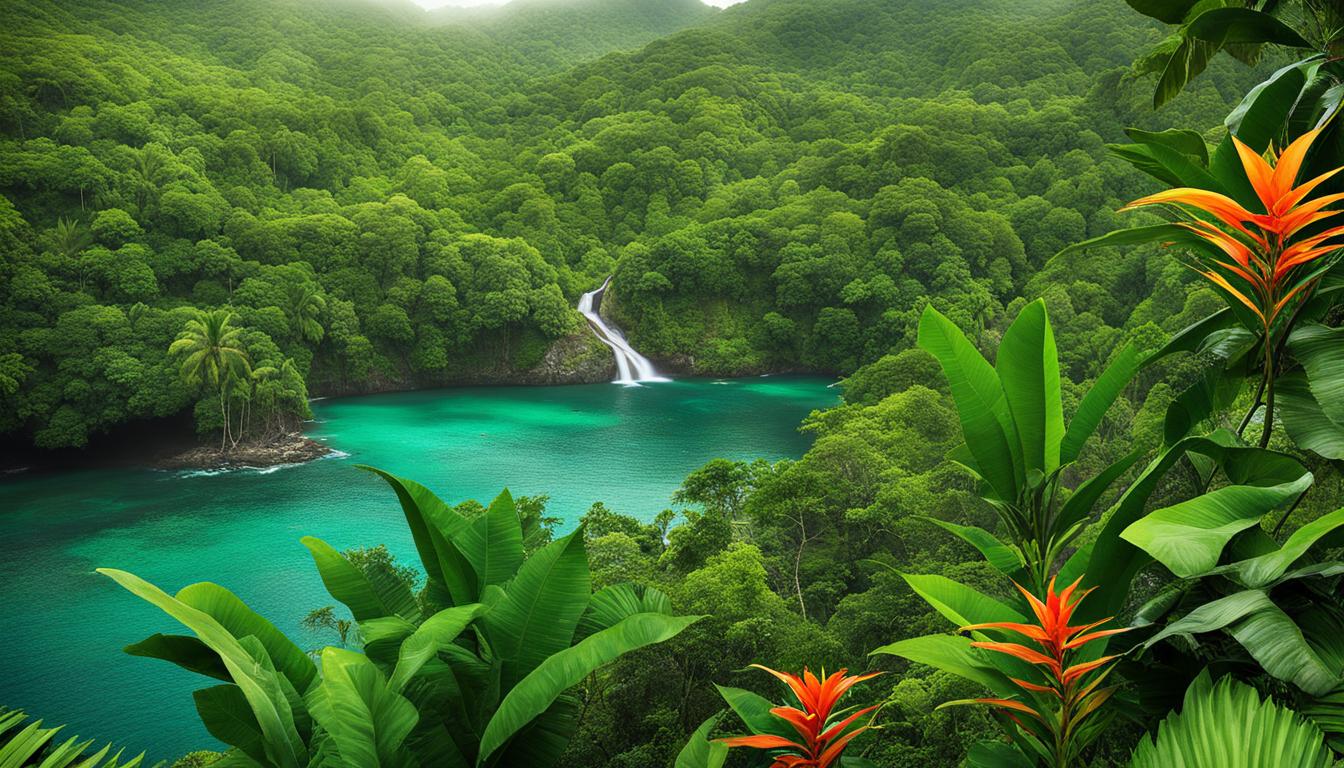Qatar Biodiversity: Animal and Plant Species and What Is Under Threat
Qatar, located on the west bank of the Arabian Gulf, boasts a unique and diverse range of flora and fauna. Despite its arid climate, the country is home to a variety of habitats, including mangroves, sand dunes, coral reefs, and mangrove swamps. With approximately 1,900 documented wild species in Qatar, including mammals, birds, reptiles, amphibians, and invertebrates, the biodiversity in this region is truly remarkable. The flora consists of 371 species of flowering plants. However, the rapid pace of modern development poses a significant threat to the biodiversity in Qatar.
Key Takeaways:
- Qatar is home to a diverse array of flora and fauna due to its unique habitats.
- The country has approximately 1,900 documented wild species and 371 species of flowering plants.
- Habitat reduction is a significant threat to the biodiversity in Qatar.
- Conservation efforts are necessary to preserve Qatar’s rich biodiversity.
- Qatar’s biodiversity contributes to its unique ecosystem and supports various ecosystem services.
Overview of Qatar’s Biodiversity
Qatar is blessed with a remarkable variety of habitats that provide a haven for a diverse range of wildlife species. From the lush mangroves to the towering sand dunes and vibrant coral reefs, the country’s ecosystems teem with life. In fact, Qatar is home to approximately 1,900 documented wild species, encompassing mammals, birds, reptiles, amphibians, and invertebrates.
This rich tapestry of biodiversity paints a vivid picture of the interconnectedness of life in Qatar. Particularly noteworthy is the country’s marine habitats, which boast an incredible array of species. With 995 marine species identified, Qatar’s waters are a treasure trove of biodiversity.
Did you know?
In Qatar, you will find endangered species such as the Hawksbill turtle, Leatherback turtle, and Dugong dwelling within these marine habitats. Their presence is a testament to the significance of Qatar’s commitment to conservation efforts.
Terrestrial habitats in Qatar are equally important, supporting a wide range of species. Among the endangered species that call Qatar home are the Arabian oryx, Greater spotted eagle, and Corn crake.
Take a moment to appreciate the sheer beauty and diversity of Qatar’s wildlife with this captivating image:
Table: Endangered Species in Qatar
| Common Name | Scientific Name | Conservation Status |
|---|---|---|
| Arabian Oryx | Oryx leucoryx | Endangered |
| Greater Spotted Eagle | Clanga clanga | Endangered |
| Corn Crake | Crex crex | Endangered |
Qatar’s commitment to conserving its precious biodiversity is essential not only for the preservation of these remarkable species but also for ensuring the balance and resilience of ecosystems. Join us as we explore Qatar’s terrestrial biodiversity in the next section.
Terrestrial Biodiversity in Qatar
Qatar boasts a diverse range of terrestrial species, including eight species of mammals, 242 species of birds, 29 reptilian species, one amphibian, and 228 species of invertebrates. These unique creatures contribute to the rich terrestrial biodiversity in Qatar.
The biodiversity inventory reveals that approximately 78% of terrestrial species in Qatar are considered rare, emphasizing the importance of protecting and conserving these precious organisms. Among the endangered mammals in Qatar, the Arabian oryx stands out as a critically endangered species that requires urgent attention for its preservation.
Furthermore, Qatar serves as a crucial habitat for migratory bird species, enhancing the country’s terrestrial biodiversity. These migratory birds play a vital role in maintaining the ecological balance and are a testament to the significance of Qatar as a sanctuary for avian diversity.

“The biodiversity in Qatar is a treasure that needs safeguarding. By protecting the rare terrestrial species and preserving their habitats, we can ensure a sustainable future for our biodiversity.
– Conservationist, Dr. Sarah Williams
Endangered Mammals in Qatar
| Mammal | Status |
|---|---|
| Arabian Oryx | Critically Endangered |
Bird Species in Qatar
| Total Number of Bird Species | Migratory Bird Species |
|---|---|
| 242 | Significant |
Marine Biodiversity in Qatar
Qatar’s marine habitats are incredibly diverse, providing a home to a wide range of marine species. With approximately 995 identified species, including 379 invertebrates and 20 bird species, the waters of Qatar are teeming with life. Notably, some of these marine species are classified as globally endangered, such as the Hawksbill turtle, Leatherback turtle, and Dugong.
The marine biodiversity in Qatar is sustained by the diverse habitats found within its waters, including coral reefs, sea grass beds, and mangrove swamps. These habitats play a vital role in supporting and protecting endangered marine species, creating a delicate balance of life within the marine ecosystem.

Threats to Biodiversity in Qatar
One of the major threats to biodiversity in Qatar is habitat reduction, which is a result of modern development. The rapid pace of industrialization and urbanization has led to the destruction of natural habitats and the loss of biodiversity. This habitat reduction has had a significant impact on the diverse range of species that call Qatar home.
In addition to habitat reduction, there are other significant threats to biodiversity in Qatar. Climate change is a growing concern, as it can affect the distribution and abundance of species. Rising temperatures, changes in rainfall patterns, and sea-level rise can all impact the survival and reproductive success of many species.
Pollution is another threat to biodiversity in Qatar. The release of pollutants into the environment can have detrimental effects on ecosystems and the organisms living in them. From air pollution caused by industrial emissions to water pollution from untreated sewage and chemical runoff, these pollutants can disrupt ecological processes and harm species.
The introduction of invasive species is also a major threat to Qatar’s biodiversity. Invasive species are non-native organisms that can outcompete and displace native species, leading to the disruption of ecosystems. These species often have no natural predators or diseases in their new habitats, allowing them to quickly establish themselves and become a dominant force.
Lastly, overexploitation of natural resources poses a threat to biodiversity in Qatar. Human activities such as overfishing, illegal hunting, and habitat destruction for agriculture and development can deplete populations of species and disrupt ecosystems.
“The destruction of natural habitats, climate change, pollution, invasive species, and overexploitation are all major threats to biodiversity in Qatar.”
It is crucial that measures are taken to address these threats in order to preserve the unique biodiversity of Qatar. Conservation efforts, such as the establishment of protected areas and the implementation of sustainable practices, are essential for the long-term survival of species and ecosystems.
To visually depict the impact of these threats on Qatar’s biodiversity, here is a table showcasing the major threats as well as their effects:
| Threat | Effect on Biodiversity |
|---|---|
| Habitat reduction | Loss of biodiversity due to destruction of natural habitats |
| Climate change | Altered distribution and abundance of species |
| Pollution | Disruption of ecosystems and harm to species |
| Invasive species | Outcompetition and displacement of native species |
| Overexploitation | Depletion of species populations and disruption of ecosystems |

Protected Areas in Qatar
Qatar has taken significant steps to protect its unique ecosystems and preserve its biodiversity by establishing both terrestrial and marine protected areas. These protected areas play a crucial role in safeguarding key biological sites and managing species of special concern. Currently, Qatar has established 5 terrestrial protected areas, covering approximately 18% of the country’s land area, and 3 marine protected areas, representing a diverse range of habitats.
The terrestrial protected areas in Qatar aim to conserve representative examples of the country’s major ecosystems, providing a safe haven for numerous plant and animal species. These protected areas are strategically located to ensure the preservation of critical habitats, such as mangroves, sand dunes, and coral reefs.
Similarly, the marine protected areas in Qatar are vital for the conservation of the country’s rich marine biodiversity. These areas encompass diverse habitats, including coral reefs, sea grass beds, and mangrove swamps, which serve as essential breeding grounds and habitats for marine species.
Efforts are underway to expand the national system of protected areas in Qatar, with a focus on strengthening the management of existing protected areas and identifying new sites for conservation. These conservation initiatives are essential to ensure the long-term viability of Qatar’s ecosystems and the protection of its unique and endangered species.
To provide you with a visual representation, here is a table summarizing the protected areas in Qatar:
| Protected Area Type | Number of Protected Areas | Area Coverage |
|---|---|---|
| Terrestrial | 5 | Approximately 18% of land area |
| Marine | 3 | Various habitat types |

These protected areas in Qatar are invaluable in preserving the country’s natural heritage, promoting biodiversity conservation, and supporting sustainable development. By proactively safeguarding these areas, Qatar is making a significant contribution to global conservation efforts and ensuring the long-term survival of its ecosystems and species.
National Biodiversity Strategy and Action Plan in Qatar
Qatar is committed to the conservation of its biodiversity and has developed a comprehensive National Biodiversity Strategy and Action Plan (NBSAP) to guide its efforts. The NBSAP comprises 11 strategic goals that cover various aspects of biodiversity conservation and sustainable development.
- Protected Areas: The NBSAP emphasizes the establishment and management of protected areas in Qatar. These areas serve as refuges for important habitats and endangered species, ensuring their long-term survival.
- Ecotourism: The plan recognizes the potential of ecotourism in promoting biodiversity conservation. By implementing sustainable tourism practices, Qatar can raise awareness about its unique ecosystems and contribute to their preservation.
- Marine and Coastal Resources: Qatar’s marine habitats are rich in biodiversity, and the NBSAP highlights the need for their protection. It aims to conserve and restore coral reefs, seagrass beds, and mangrove swamps that provide critical habitats for numerous marine species.
- Environmental Legislation: The NBSAP acknowledges the importance of robust environmental legislation to ensure the effective conservation of biodiversity. Qatar aims to strengthen its legal framework for environmental protection and establish mechanisms for enforcing conservation laws.
- Scientific Research: To enhance knowledge about Qatar’s biodiversity, the NBSAP encourages the promotion of scientific research. By supporting research projects and collaborations, Qatar aims to improve its understanding of local ecosystems and contribute valuable data to global research efforts.
- Education and Public Awareness: The plan recognizes the importance of education and public awareness in fostering a culture of biodiversity conservation. Qatar aims to educate its citizens about the value of biodiversity and implement outreach programs to engage the public in conservation activities.
- Multilateral Environmental Agreements: Qatar is committed to fulfilling its obligations under international agreements related to biodiversity conservation. The NBSAP aims to strengthen Qatar’s participation in multilateral environmental agreements and promote global cooperation for biodiversity protection.
The National Biodiversity Strategy and Action Plan in Qatar serves as a roadmap for preserving the country’s unique biodiversity, promoting sustainable development, and enhancing biodiversity research and monitoring.

Implementation of the Convention on Biological Diversity in Qatar
Qatar is dedicated to the implementation of the Convention on Biological Diversity (CBD) and has put in place legislation to address the protection of habitats and conservation of species. The country has made significant progress in enhancing its institutional capacity for effective biodiversity management. Furthermore, Qatar is actively working towards strengthening cross-sectoral cooperation to achieve its conservation goals. It recognizes that public awareness and participation are vital in reaching the target set for biodiversity conservation.
The Commitment to Conservation
“Our commitment to conserving the biodiversity in Qatar goes beyond words. We have taken concrete steps to protect habitats and species and are constantly improving our efforts. By implementing the provisions of the CBD and fostering collaboration, we aim to create a sustainable future for our natural heritage.”
Qatar’s strong dedication to conserving biodiversity is evident through its proactive approach in enacting laws and regulations that address the protection of habitats and species. By doing so, the country ensures that the unique flora and fauna of Qatar are preserved for future generations to appreciate and benefit from.
Enhancing Biodiversity Management
- Enacting legislation to protect habitats and species
- Strengthening institutional capacity for effective biodiversity management
- Promoting cross-sectoral cooperation and collaboration
Qatar has significantly improved its institutional capacity for enhanced biodiversity management. By investing in the necessary infrastructure and resources, the country is better equipped to protect and conserve its diverse ecosystems and species. Cross-sectoral cooperation is also being fostered to ensure a coordinated approach towards conservation, involving various stakeholders from government agencies, non-governmental organizations (NGOs), and the public.
Public Awareness and Participation
In Qatar, public awareness and participation are considered essential pillars for achieving the 2010 Target for biodiversity conservation. Recognizing the importance of engaging the public, Qatar actively promotes awareness campaigns, educational initiatives, and citizen science programs to involve individuals in conservation efforts.
By empowering communities and raising awareness about the importance of biodiversity, Qatar aims to create a sense of stewardship towards its natural heritage. This collective effort will contribute to the overall conservation goals and ensure the long-term sustainability of Qatar’s unique ecosystems.
| Conservation Effort | Key Actions |
|---|---|
| Legislation and Policy Development | Enactment of laws to protect habitats and species |
| Institutional Capacity Building | Enhancement of resources and infrastructure for effective biodiversity management |
| Cross-Sectoral Cooperation | Promotion of collaboration among government agencies, NGOs, and the public |
| Public Awareness and Participation | Education programs, awareness campaigns, and citizen science initiatives |

The image above showcases the dedication of Qatar to biodiversity conservation. Through various initiatives and collaborative efforts, Qatar is actively working towards protecting its unique flora and fauna.
Initiatives in Protected Areas in Qatar
Qatar is dedicated to effectively managing its protected areas and implementing measures to ensure the conservation of its unique biodiversity. Various initiatives have been undertaken to enhance the management of protected areas and strengthen the legal framework for their protection.
One key aspect of protected area management in Qatar is the restoration of endangered wildlife species. Several protected areas serve as sites for species reintroductions, aiding in their recovery and providing a safe environment for their survival.
Efforts are also being made to expand research work in protected areas, furthering our understanding of the ecosystems and species within them. This research plays a vital role in informing conservation strategies and promoting evidence-based decision-making.
To ensure the effectiveness of protected area management, regular revisions of management plans are conducted. These revisions incorporate new knowledge gained through research and address any emerging challenges or opportunities.
Moreover, there is a strong emphasis on improving community participation in the management of protected areas in Qatar. Recognizing the value of local knowledge and engagement, initiatives are underway to involve communities in conservation efforts and provide them with opportunities to contribute to the sustainable management of these areas.
Overall, Qatar’s initiatives in protected areas management showcase a commitment to biodiversity conservation and sustainable development. By fostering collaboration between government agencies, researchers, and local communities, these initiatives aim to protect Qatar’s natural heritage for future generations.

| Initiative | Description |
|---|---|
| Capacity Improvement | Efforts to enhance the capacity of protected area management authorities through training and resource allocation. |
| Legal Regime Strengthening | Revision and implementation of laws and regulations to provide stronger legal protection for Qatar’s protected areas. |
| Species Reintroductions | Restoration of endangered wildlife species through reintroductions in select protected areas, contributing to species recovery and conservation. |
| Research Expansion | Increased research efforts within protected areas to gather crucial data on ecosystems, species, and threats, informing conservation strategies. |
| Management Plan Revisions | Regular reviews and updates of protected area management plans, incorporating new knowledge and addressing emerging challenges. |
| Community Participation | Promoting local community involvement in the management of protected areas, recognizing the importance of local knowledge and stewardship. |
Challenges and Opportunities for Conservation in Qatar
Conserving biodiversity in Qatar poses several challenges that require careful attention and action. The country faces the ongoing threat of habitat destruction, driven by rapid urbanization and industrialization. This destruction reduces the available space for wildlife and disrupts ecosystems, endangering many species.
Climate change also presents a significant challenge to biodiversity conservation in Qatar. Rising temperatures and changes in precipitation patterns can negatively impact the distribution and abundance of species, as well as the availability of suitable habitats.
Pollution further compounds these challenges, with pollutants in the air, water, and soil posing threats to both terrestrial and marine ecosystems. Pollution can disrupt ecosystem processes, harm wildlife, and degrade habitats.
Additionally, the introduction of invasive species can have detrimental effects on native flora and fauna, disrupting ecological balance and ecosystem functioning.
Despite these challenges, Qatar also possesses opportunities for promoting biodiversity conservation. The country recognizes the importance of sustainable development and is actively exploring ecologically based initiatives to mitigate the impact of human activities on the environment.
Research and collaboration play a crucial role in understanding and addressing the specific challenges faced by Qatar’s biodiversity. By investing in scientific studies and fostering partnerships with local and international organizations, Qatar can develop innovative conservation strategies tailored to its unique ecosystems.
Figure: The challenges and opportunities for conservation in Qatar
Importance of Biodiversity Conservation in Qatar
Biodiversity conservation plays a crucial role in Qatar to safeguard the extraordinary array of flora and fauna that inhabit the nation, ensuring the preservation of essential ecosystem services provided by natural habitats. By focusing on the conservation of biodiversity, Qatar can prevent the loss of valuable species and ecosystems, promote sustainable utilization of natural resources, and contribute to global conservation efforts.
Preserving biodiversity in Qatar is vital to maintain the delicate balance of ecosystems and protect the unique plants and animals that are intricately linked to the country’s natural heritage. The diverse range of species found in Qatar’s terrestrial and marine habitats provide valuable ecological functions, such as pollination, seed dispersal, and nutrient cycling, which are essential for the overall health and resilience of ecosystems.
Conservation efforts in Qatar are not only crucial for environmental reasons but also for the economic and social benefits they bring. By protecting biodiversity, Qatar can promote ecotourism, attracting visitors interested in experiencing the country’s rich natural landscapes and diverse wildlife. Additionally, conserving biodiversity can enhance scientific research opportunities, allowing for a deeper understanding of Qatar’s unique ecosystems and the development of innovative conservation strategies.
Furthermore, Qatar’s commitment to biodiversity preservation contributes to global conservation efforts. By safeguarding its natural resources, Qatar demonstrates responsible environmental stewardship and sets an example for other nations to follow. Collaborative efforts and knowledge sharing in biodiversity conservation can lead to advancements in research, policy, and conservation practices that benefit not only Qatar but also the global community.
Overall, the importance of biodiversity conservation in Qatar cannot be overstated. Protecting and conserving the country’s unique flora and fauna is essential for maintaining the integrity of ecosystems, preserving valuable ecosystem services, promoting sustainable development, and contributing to global efforts to protect biodiversity and ensure a sustainable future.
Benefits of Biodiversity Conservation in Qatar
| Benefits | Description |
|---|---|
| Ecosystem Services | Maintains essential ecological functions, such as pollination, seed dispersal, and nutrient cycling. |
| Ecotourism | Promotes tourism and attracts visitors interested in experiencing Qatar’s unique natural landscapes and wildlife. |
| Scientific Research | Enhances research opportunities, leading to a deeper understanding of Qatar’s ecosystems and the development of innovative conservation strategies. |
| Global Conservation | Contributes to global conservation efforts, showcasing responsible environmental stewardship and inspiring others to protect biodiversity. |
Conclusion
Qatar’s biodiversity is a precious asset that needs to be protected and conserved. The country’s unique flora and fauna are facing numerous threats, including habitat destruction and other human activities. However, there is hope as Qatar is taking proactive steps to safeguard its biodiversity.
The establishment of protected areas, guided by the National Biodiversity Strategy and Action Plan, is a crucial initiative in preserving Qatar’s natural treasures. These areas act as sanctuaries for various species and ensure their habitats remain intact. Additionally, conservation measures are being strengthened to mitigate the impacts of climate change, pollution, and the introduction of invasive species.
By prioritizing the preservation of its biodiversity and collaborating with national and global partners, Qatar can continue to be a beacon of environmental conservation. The country’s efforts not only contribute to protecting its own natural heritage but also play a significant role in global conservation endeavors. With sustained commitment, Qatar can preserve its biodiversity for future generations and inspire others to follow suit.
FAQ
What is the biodiversity like in Qatar?
Qatar has a rich biodiversity, with approximately 1,900 documented wild species, including mammals, birds, reptiles, amphibians, and invertebrates. There are also 371 species of flowering plants.
What are some of the endangered species in Qatar?
Some of the endangered species in Qatar include the Arabian oryx, Greater spotted eagle, Corn crake, Hawksbill turtle, Leatherback turtle, and Dugong.
What is the terrestrial biodiversity like in Qatar?
Qatar is home to eight species of mammals, 242 species of birds, 29 reptilian species, one amphibian, and 228 species of invertebrates. Approximately 78% of terrestrial species in Qatar are considered rare.
What is the marine biodiversity like in Qatar?
Qatar has approximately 995 marine species, including 379 species of invertebrates and 20 species of birds. Endangered marine species found in Qatar include the Hawksbill turtle, Leatherback turtle, and Dugong.
What are the threats to biodiversity in Qatar?
The major threats to biodiversity in Qatar include habitat reduction, climate change, pollution, invasive species, and overexploitation.
How many protected areas are there in Qatar?
Qatar has five terrestrial protected areas and three marine protected areas, covering approximately 18% of the total land area.
What is the National Biodiversity Strategy and Action Plan in Qatar?
The National Biodiversity Strategy and Action Plan in Qatar is a comprehensive plan that includes 11 strategic goals, covering areas such as protected areas, ecotourism, marine and coastal resources, and environmental legislation, among others.
How is the Convention on Biological Diversity implemented in Qatar?
Qatar has enacted legislation to address habitat protection and species conservation. The country is committed to implementing the provisions of the Convention on Biological Diversity and has improved its institutional capacity for enhanced biodiversity management.
What initiatives are being taken in protected areas in Qatar?
Efforts are being made to improve the management of protected areas in Qatar, including capacity improvement, strengthening the legal regime for protection, and involving local communities in the management process.
What are the challenges and opportunities for conservation in Qatar?
Qatar faces challenges such as habitat destruction, climate change, pollution, and invasive species. However, there are opportunities for conservation through sustainable development and research collaboration.
Why is biodiversity conservation important in Qatar?
Biodiversity conservation is crucial in Qatar to protect the unique flora and fauna, maintain ecosystem services, promote ecotourism, enhance scientific research, and contribute to global conservation efforts.








